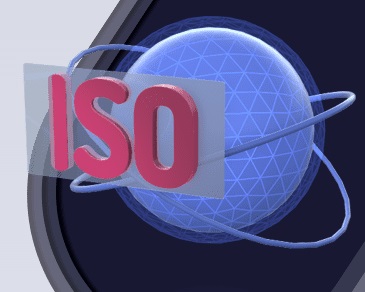What Is ISO Compliance & How Does it Enhance Global Brand Reputation?
Compliance with ISO standards means that an organization follows best practices as outlined by ISO, which often involves implementing rigorous processes and controls to manage risks and ensure consistent quality.
Published April 5, 2025.

As modern businesses navigate increasingly complex global markets, the demand for transparency and security has never been higher. Customers, partners, and regulators alike expect organizations to adhere to stringent guidelines that ensure the integrity and security of their operations.
Among these, ISO compliance stands out as an important factor in establishing and maintaining both trust and credibility on a global scale. Achieving ISO compliance not only demonstrates a company's commitment to quality and security but also serves as a tool for enhancing the brand's reputation.
» Ready to become ISO compliant? Find out how GRSee can help
What Is ISO Compliance?
ISO compliance refers to an organization’s adherence to the standards set by the International Organization for Standardization (ISO). ISO is an independent, non-governmental international organization that develops standards to ensure the quality, safety, efficiency, and security of products, services, and systems across various industries.
Good compliance with ISO standards means that an organization follows best practices as outlined by ISO, which often involves implementing rigorous processes and controls to manage risks and ensure consistent quality.
» Struggling with startup security? Here are some cyber tips for your startup plan
ISO compliance is relevant to organizations globally because it provides a universally recognized framework for operational excellence. Unlike other regulatory standards that may be region-specific or industry-focused, ISO standards are designed to be applicable across borders and sectors, making them essential for companies operating in the global marketplace.
For instance, while the General Data Protection Regulation (GDPR) focuses on data protection within the European Union, ISO standards such as ISO 27001 (information security) are recognized and valued worldwide, providing a common language for quality and security.
» Find out how to use ISO 27001 to reach CCPA compliance
ISO-Compliant vs. ISO-Certified
- An ISO-compliant organization adheres to the processes and best practices outlined in ISO standards but has not undergone a formal certification process. This means that while the organization may follow ISO guidelines internally, it has not been externally audited by an accredited certification body to verify its compliance.
- An ISO-certified organization has not only implemented ISO standards but has also successfully completed a rigorous audit by an accredited third-party auditor. This certification serves as formal recognition that the organization meets the stringent requirements of the ISO standard.
» Discover why you need to be ISO certified
Objectives of ISO Standards
The primary objective of ISO standards is to provide a structured framework for managing and improving an organization’s operations, with a focus on quality, security, and efficiency. These standards help organizations identify and mitigate risks, streamline processes, and ensure consistent quality across all areas.
Explaining ISO 27001
ISO 27001 is a part of the ISO 27 standards family, which specifically addresses information security. ISO 27001, one of the most well-known standards, focuses on information security management. Its goal is to protect an organization’s information assets by implementing a robust information security management system (ISMS). This involves:
- Defining the ISMS scope
- Assessing risks
- Implementing controls
- Continuously monitoring and improving the system
ISO Compliance Across Various Sectors
ISO compliance varies across industries and is shaped by specific needs and regulatory pressures. For example:
- Healthcare: ISO 27001 is vital for securing electronic health records (EHRs) and ensuring patient data protection, meeting both regulatory requirements and maintaining trust. Compliance in this sector safeguards patient privacy and supports adherence to industry standards.
- Manufacturing: ISO compliance emphasizes quality management and process control through a set of standards, which ensure product consistency and reliability.
- Finance: ISO 27001 is crucial in managing information security and operational risks. Financial institutions use these standards to protect customer data, maintain system integrity, and prevent data breaches or fraud.
» See these cybersecurity risks in healthcare
Benefits of ISO 27001 Compliance
Enhanced information security
ISO 27001 compliance significantly strengthens an organization’s defenses against data breaches and cyberattacks by implementing robust controls and risk management practices.
Improved reputation
Achieving ISO 27001 certification can significantly boost an organization’s reputation, especially in B2B environments where certification is often a prerequisite for doing business.
Competitive advantage
For industries handling sensitive data, such as SaaS or healthcare companies, ISO 27001 compliance provides a competitive edge by demonstrating a commitment to safeguarding information and building trust with clients and partners.
Operational improvements
The structured approach of ISO 27001 encourages organizations to regularly assess and refine their security practices, leading to increased maturity of their information security management systems.
Business continuity
By identifying and managing risks, ISO 27001 compliance supports the continuous operation of critical business functions, reducing downtime and ensuring resilience in the face of security incidents.
5 Key Steps to Achieve ISO Compliance
1. Conduct a Gap Assessment
This involves evaluating the organization’s current processes, policies, and controls to identify areas where they fall short of ISO standards. During this phase, you should:
- Identify gaps: Review existing practices to pinpoint discrepancies between current operations and the requirements outlined in ISO standards.
- Develop a roadmap: Based on the identified gaps, create a detailed action plan that outlines the steps needed to address deficiencies and align with ISO standards.
This initial assessment is critical as it sets the foundation for the entire compliance process, ensuring that all necessary changes are systematically planned and implemented.
2. Implement Required Controls and Processes
Once the gap assessment is complete, the organization must begin implementing the necessary controls and processes to meet ISO standards. This step typically involves:
- Policy development: Creating or updating policies to reflect ISO requirements, ensuring that they are comprehensive and enforceable across the organization.
- Training and awareness: Educating employees about new policies and processes and ensuring they understand their roles in maintaining compliance.
- Process integration: Integrating new controls into daily operations, ensuring that all activities are conducted in accordance with ISO standards.
3. Internal Auditing: A Critical Checkpoint
Before undergoing the formal certification audit, it is important to conduct an internal audit, ensuring the following steps:
- Review implementation: Assess the effectiveness of the new controls and processes that have been put in place.
- Identify and correct issues: Detect any remaining issues or non-conformities and address them before the external audit.
- Prepare for certification: Ensure that all documentation is up-to-date and that the organization is fully prepared for the certification audit.
The internal audit acts as a safety net, allowing the organization to correct any last-minute issues and approach the external audit with confidence.
4. External Audit and Certification
The final step in achieving ISO compliance is the external audit, conducted by an accredited certification body. This audit will:
- Evaluate compliance: The external auditor will thoroughly review the organization’s policies, processes, and controls to ensure they meet ISO standards.
- Issue certification: If the organization passes the audit, it will be awarded ISO certification that is typically valid for three years.
5. Maintain Ongoing Compliance: Surveillance Audits and Re-certification
ISO compliance does not end with certification. Organizations must engage in ongoing efforts to maintain their certified status. This includes:
- Continuous monitoring
- Regular updates to processes
- Ongoing commitment from the organization
» Learn more: Become ISO 27001 compliant in 11 easy steps
Overcoming Possible ISO-Compliance Challenges With GRSee
While achieving ISO compliance offers significant benefits, it can also offer the following challenges:
Complex documentation: ISO compliance requires extensive documentation, which can be overwhelming for organizations that are not familiar with the process. Ensuring that all required documents are accurate and up-to-date can be a time-consuming and resource-intensive task.
Resource constraints: Implementing ISO standards may require significant investments in terms of time, money, and personnel. Organizations with limited resources may struggle to allocate the necessary support for compliance efforts.
Lack of internal expertise: ISO compliance involves specialized knowledge of standards and best practices. Organizations that lack internal expertise may find it difficult to navigate the compliance process without external support.
To overcome these challenges, consider partnering with external consultants or compliance management firms that specialize in ISO standards such as GRSee. When it comes to compliance and certification, experts can provide valuable guidance and support throughout the compliance journey.
GRSee's extensive experience offers a comprehensive range of services designed to help organizations achieve and maintain ISO compliance, providing support from the initial assessment stages through successful certification and beyond. Our tailored services include gap assessments, policy development, employee training, and internal audits, all aimed at making the certification process as smooth and efficient as possible.








